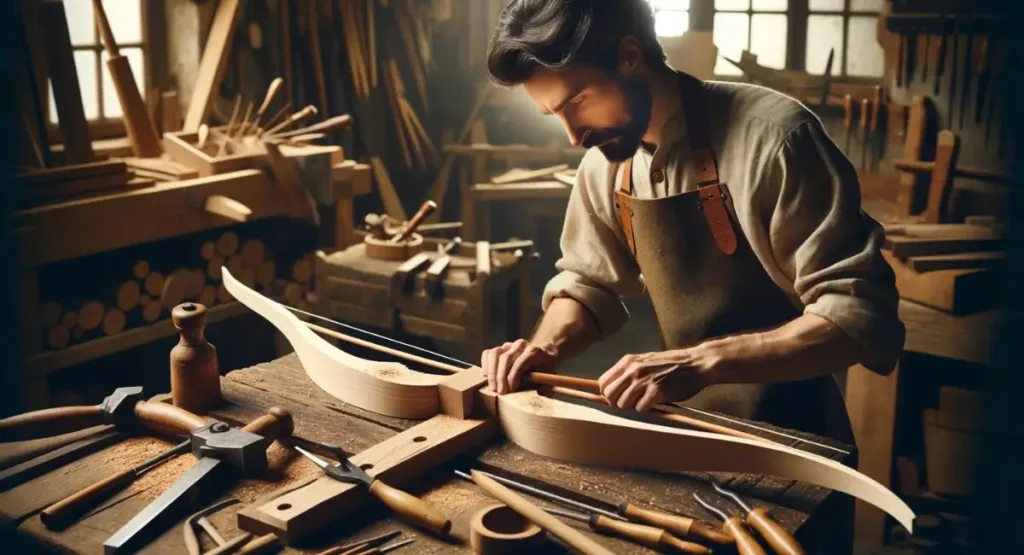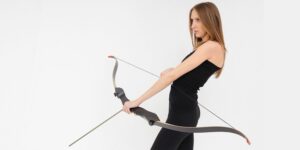Imagine the tradition of archery, where the bow, once an essential tool for hunting and warfare, has now found its place in modern sport and recreation. Central to this tradition is the crafting of bows, a practice intricately tied to the selection of the right wood—the very soul of any bow. For woodworking hobbyists, archery enthusiasts, and outdoor sports fans looking to explore the craft, understanding the types of wood available and the benefits they bring is paramount.
Mastering the art of selecting archery bow wood is not only about tradition and aesthetics but also performance, accuracy, and most importantly, personal satisfaction. In this comprehensive guide, we’ll take a deep dive into the world of archery bow wood, breaking down its various types and the unique advantages each type offers.
Archery Bow Wood: An Introduction
When it comes to the bow, the wood is more than just a raw material; it is the backbone of the archer’s experience. The process of choosing just the right wood for archery bows is an age-old tradition, steeped in knowledge and respect for the craft. Each type of wood carries its own characteristics, ranging from strength and flexibility to grain tightness and color. Understanding these qualities will help woodworking hobbyists create bows that not only look stunning but also perform incredibly well.
Types of Wood for Archery Bows
Yew Wood
Yew wood is legendary in the world of archery, known for its historical significance and desirable characteristics. Yew was the wood of choice for the English longbow, a staple in medieval warfare. What makes yew exceptional is its perfect blend of strength and flexibility, essential for a bow’s effective energy storage and release. However, it’s important to note that yew wood is scarce and must be sourced responsibly.
Osage Orange
Osage Orange, also known as hedge apple or bodark, is a resilient hardwood with a bright golden hue. With a significantly more elastic modulus than most woods, Osage Orange bends without breaking, making it an excellent option for flat bows. It’s also known for its high performance, allowing for a quick and powerful shot.
Bamboo
Bamboo might not be a conventional “wood,” but it’s a material renowned for its high strength-to-weight ratio. When used in backed bows, bamboo provides the flexibility to bend freely, allowing it to store more energy and deliver faster arrows. The combination of bamboo and a suitable belly wood can create a bow that rivals any in performance.
Hickory
Hickory is a robust and lightweight wood that has been used in tool handles, furniture, and sports equipment. In archery, it is appreciated for its straight grain, which makes it less likely to break under tension. Hickory bows are known for their durability and can be excellent for beginners or anyone interested in crafting a long-lasting bow.
Also Read : The Ultimate Guide To Bow And Arrow For Beginners
Benefits of Each Wood Type
Strength and Flexibility
For a bow, strength without the ability to bend and flexibility without strength are both essential. Yew and Osage Orange provide an excellent balance, allowing for a smooth draw and powerful release. Bamboo supplements this further, adding a ‘spring’ to the bow’s step, while Hickory’s straight grain ensures that the bow can take the strain.
Durability
A well-crafted bow should stand the test of time. Osage Orange and Hickory are both woods known for their longevity, capable of withstanding the repetitive stress of shooting. On the other hand, although Yew is a softer wood, its historical significance and the mystique that surrounds it can make it a desirable choice for bowyers who want to recreate ancient styles.
Performance Characteristics
The materials from which bows are made can significantly affect performance. Bows made with Osage Orange can be fast and powerful, while those with Yew may offer a smoother, quieter release. Bamboo’s high tensile strength allows for a fast recovery after a shot, ensuring consistent and accurate shooting.
Considerations for Woodworking Hobbyists
Availability and Sourcing
Many types of wood in archery bows have limitations in availability due to ecological or legal reasons. Yew, for instance, is a slow-growing tree, and sourcing it sustainably may be challenging. Conversely, Osage Orange, while still to be handled responsibly, can offer a more readily available alternative for a quality archery bow.
Workability and Finishing
The wood in archery bows you select should not only be strong and flexible but also workable. Hickory, with its reputation in traditional woodworking, is easy to cut, plane, and shape. Finishing the bow is also important, requiring knowledge of how different woods react to stains, oils, and varnishes to achieve your desired look and protection.
Cost-Effectiveness
The cost of materials is always a consideration in any woodworking project. Yew, due to its scarcity, may be more expensive and is often considered a premium choice. Hickory, on the other hand, is more cost-effective and widely available, making it a popular choice for beginners and seasoned bowyers alike.
Also Read : 5 Best Tips for Traditional Archery: Art of Precision and Accuracy
Impact on Archery Enthusiasts and Outdoor Sports Fans
Improved Accuracy and Precision
The choice of archery bow wood can impact the bow’s performance, and by extension, the archer’s accuracy. A bow made with Osage Orange or Yew, with their superior combinations of strength and flexibility, can offer stable and predictable shooting. The alignment of the grain in Hickory bows can also contribute to consistency in shot placement.
Enhanced Shooting Experience
The bow is an extension of the archer, and the right wood for archery bows can significantly alter the feel of shooting. Bamboo, with its natural vibration dampening qualities, can provide a smooth draw and minimal hand shock. Each type of wood offers a unique experience, and it’s the subtle differences that can make the sport all the more engaging.
Longevity of the Bow
An archery bow is a piece of art, a tool, and an investment. With proper care, a bow can last for generations, with some Osage Orange and Yew bows passed down through families. The durability inherent in the wood for archery bows chosen can ensure the bow’s longevity, allowing it to be used and enjoyed for years to come.
Conclusion : Wood in Archery Bows
The significance of wood in archery bows goes beyond mere construction. Each type of wood has its own story to tell and brings its distinct advantages to the craft. For woodworking hobbyists, selecting the right wood is a crucial first step in creating a bow that not only performs well but also reflects the love and dedication you put into it. Archery enthusiasts and outdoor sports fans understand the bond between archer and bow, and how the wood chosen can enhance the entire experience. It’s a delicate dance between tradition, performance, and personal connection—one that is navigated with knowledge, skill, and reverence.
In conclusion, the choice of wood for archery bows is a deeply personal one, influenced by tradition, practicality, and passion. Each wood type carries with it a legacy that can be felt in every arrow loosed. For those engaging in this craft, the message is clear: take the time to understand the wood, and you’ll craft a bow that not only hits the mark but becomes part of your own archery story. Whether you’re seeking to hone your woodworking skills or enhance your archery experience, the road to a perfect archery bow begins with knowing your wood.
Recent Posts
- Discover The Art Of Crossbows And Their Many Uses
- Longbows For Beginners: A Beginner’s Guide
- Discover The Joy Of Archery With A Bow And Arrow For Beginners
- Traditional Archery For Beginners – Getting Started
- Hit The Target With This Ultimate Guide To Archery For Beginners
- Mastering The Art Of Recurve Bow Archery For Beginners







